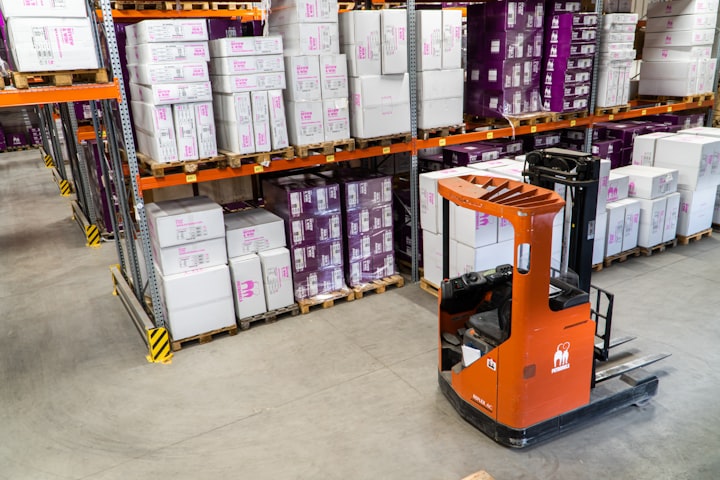Let's have a look at modernized IoT tools that can be used to assist in running a successful green inventory management system.
Some of the following strategies have been discussed in academic research papers, that have been listed in the reference section at the bottom of this report in accordance with the numbers listed in bold.
1. The first step before implementing or actively moving towards sustainable inventory management is setting up the foundation from the start. Perform effective inventory planning by the management team. This can be done by researching what is needed according to your industry in terms of rules, regulations and tools that need to be implemented. Delegate the roles to the right employees in the inventory system and hold them accountable to report and monitor performance in regards to sustainable inventory.
2. Familiarise with the environmental, social, and economic procedures that determine a sustainable approach to managing, tracking, and monitoring inventory. The main aim and challenge should be on minimising environmental damage through carbon emissions and pollution while at the same time minimizing costs.
3. Run educational workshops from time to time to educate the employees on the best modern ways to perform the inventory actions in a sustainable way in accordance with the latest updates regarding government regulations and discoveries in terms of green technology tools.
4. Perform regular risk assessments by filtering out which companies you would like to deal with and make inventory transactions in accordance with the values and rules the company set out during the planning stage.
5. Make it a priority to engage in activities designed to assess the performance of the inventory system to ensure it follows the guidance in terms of the process of monitoring, assessing, tracking, and delivering inventory.
6. Switch to a sustainable transportation method to deliver inventory. A few solutions to this have been proposed, specifically, a study that investigated the effects of green technologies and carbon policies highlighted that freight transportation is considered to be the top unsustainable transportation method for inventory (2). Alternatively, the suggestion was to reduce the frequency of transporting inventory, however, this is not always a good choice especially when there is a large inventory system, big demand, and consistent daily orders. On the other hand, in a similar study formulated by Sayyadik and Awasthi, 2018a (6) an alternative solution is to implement simulation and ANP methods to reduce environmental pollution and save energy.
7. Switch to a sustainable way of replenishing inventory, as proposed by Validi, Bhattacharya, and Byrne (2014) (1) who discussed the importance of replenishing inventory with an emphasis on following regulations regarding carbon emissions. The solution was to implement a two-echelon supply chain model
8. Reduce carbon emissions by implementing cap-and-trade, which sets a limit on pollution making it an environmentally friendly way to reduce pollution and a cost-effective option for supply chains.
9. Implement a carbon emissions trading system that encourages supply chains to reduce and resell their leftover emissions as a result of the inventory processes.
10. Sustainably deal with unused, expired, and deteriorated items by implementing a recycling or upcycling system that works to save the environment, money and follow regulations. Recycling can be implemented in-house through storage bins or it can be delegated to an external company that collects the waste material and sustainably processes it, whether that is through reusing, recycling, or upcycling to reduce overall waste.
11. Switch to sustainable packaging methods that are recyclable, free of plastic, and environmentally friendly.
12. Switch to digital paperless communication methods, opt for email rather than sending a posted letter and electronic signatures rather than printed consent forms and reports. This helps reduce waste and emphasizes modernization values in the management of inventory.
13. Install energy-efficient lighting systems to help save money and reduce damage to the environment. A great recent example is Amazon’s decision to install solar panels in its fulfillment centers. (4)
14. Implement IoT systems and program them to do automated tasks such as keeping the warehouse clean, saving energy and reducing waste. These can be programmed and tracked from a phone or a database.
15. Follow the example of Walmart (5) where they implemented automated geothermal heating systems to save energy and make sure that temperature is maintained in the warehouse to improve shelf life.
16. Aim to minimize carbon emissions by implementing an EOQ model, developed by Wahab et al . (3)
References
(1)S. Validi, A. Bhattacharya, P.J. ByrneIntegrated low-carbon distribution system for the demand side of a product distribution supply chain: A DoE-guided MOPSO optimizer-based solution approach international Journal of Production Research, 52 (10) (2014), pp. 3074–3096
(2) W.T. Wang, H.M. Wee, Y.L. Cheng, C.L.Wen, L.E. Cárdenas-BarrónEOQ model for imperfect quality items with partial backorders and screening constraintEur. J. Ind. Eng., 9 (6) (2015), pp. 744–773(3)M.I.M. Wahab, S.M.H. Mamun, P.Ongkunarak
(3)EOQ models for a coordinated two-level international supply chain considering imperfect items and environmental impactInt. J. Prod. Econ., 134 (1) (2011), pp. 151–158
(4) ”Wal-Mart Canada opens demonstration stores to test geothermal, daylight harvesting technologies” Published in BDC Network. Date: August 11 2010, Accessed 18/11/2021Source: https://www.cnet.com/news/amazon-turns-warehouse-roofs-into-solar-power-stations/
(5) “ Amazon turns warehouse roofs into solar power stations” Published in Cnet on March 2, 2017 by Stephen Shankland, Accessed 18/11/2021Source: https://www.bdcnetwork.com/wal-mart-canada-opens-demonstration-store-test-geothermal-daylight-harvesting-technologies
(6) R. Sayyadik, A. AwasthiA simulation-based optimisation approach for identifying key determinants for sustainable transportation planningInternational Journal of Systems Science: Operations & Logistics, 5 (2)(2018), pp. 161–174
(7) Sunil Tiwari, Yosef Daryanto, Hui Ming Wee,Sustainable inventory management with deteriorating and imperfect quality items considering carbon emission, Journal of Cleaner Production,Volume 192,2018,Pages 281–292,ISSN09596526,https://doi.org/10.1016/j.jclepro.2018.04.261(https://www.sciencedirect.com/science/article/pii/S0959652618313039)
(8) Yeu-Shiang Huang, Chih-Chiang Fang, Ying-An Lin,Inventory management in supply chains with consideration of Logistics, green investment and different carbon emissions policies,Computers & Industrial Engineering, Volume 139, 2020, 106207, ISSN 0360–8352, https://doi.org/10.1016/j.cie.2019.106207(https://www.sciencedirect.com/science/article/pii/S036083521930676X)
If you would like to support my journey, then kindly subscribe to my youtube channel where I will be sharing updates as well as step-by-step guides on my passive income journey as well as business strategies and tricks. Subscribe here.
Hey 👋 If you like my work and want to support it, then you can buy me a coffee here.
About The Author
Noor is a second-year business student at Tredu. She is also studying for Diploma in International Smart Industry at Tampere University. She is passionate about marketing and content creation. She recently launched her YouTube channel specializing in holistic healing.







Comments
There are no comments for this story
Be the first to respond and start the conversation.